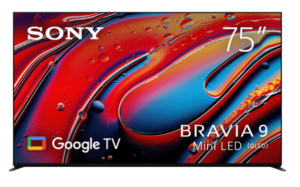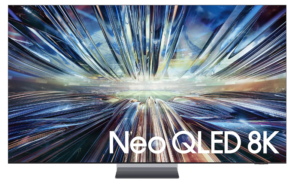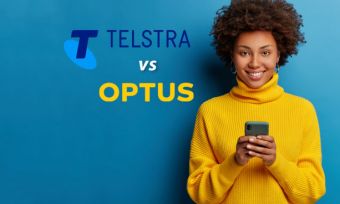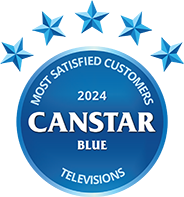Shopping for a more energy-efficient appliance?
Make sure you’re getting the best deal on energy too! Compare electricity plans now to see if you can save.
Our review compares television brands on customer satisfaction, so you can find out what other Aussies think about the compared brands before you go ahead with a purchase. Think of it as like asking hundreds of your closest mates which television brand they think is best!
Canstar Blue surveyed 1,405 Australians for their feedback on the television brand(s) they have purchased in the last three years.
The winning brand is the one that receives the highest overall satisfaction rating once all the scores from the overall satisfaction criteria are combined and averaged.
Brands must have received at least 30 responses to be included, so not all brands available in the market have been compared in this survey. The brands rated in this survey are listed below in order of best overall satisfaction.
Find more detailed information on our Most Satisfied Customer methodology.

Sony is a technology brand that manufactures televisions and home theatre systems, cameras, audio, games consoles and more. The brand’s television range has a picture quality of up to 4K, screen sizes from 32 to 98 inches and smart tv options.

Samsung is an electronics company that sells a range of consumer electronics, mobile devices, accessories and more. Samsung’s televisions include features such as artificial intelligence capabilities, bluetooth connectivity and up to 8K picture quality.

This article was written by Canstar Blue Home & Lifestyle Content Producer, Rachel Bollerman. Rachel graduated with a Bachelor of Communications, majoring in Journalism at the Queensland University of Technology in 2021. She has worked in public relations, marketing and communications roles at Jessica Cotton PR & Marketing and the Institute for Urban Indigenous Health . Gaining experience in broadcast journalism and blog writing, Rachel has also interned at 4ZZZ Community Radio and Fishburners.
When she’s not working, Rachel enjoys doing arts and crafts projects at home, watching true crime and spending time with friends. You can follow Rachel on LinkedIn.

Samantha Howse is Canstar Blue’s Consumer Research Specialist, coordinating the consumer research program behind our customer satisfaction awards across Canstar and Canstar Blue in Australia and New Zealand. Sam has earned a Bachelor of Business (Marketing) from Griffith University and, with seven years in market research and two years in marketing, she is experienced in survey design, implementation and analysis, coupled with an understanding of marketing principles and best practice.
Here are the past winners from Canstar Blue’s TV ratings:

Appliances - May 6th
In this article, Canstar Blue looks at how much standby power costs each year and which appliances are the biggest contributors.
– Read more
Best-Rated Earphones - February 27th
There are numerous apps for Android phones that cater to all musical and audio tastes. However, given there are so many options, it can be difficult to know which apps are worth downloading.
In this article, …
– Read more
Best-Rated Television Brand - November 14th
Whether you’re getting a start on Christmas shopping, or just want to treat yourself to the latest tech, the Black Friday sales period is a great time to save on a wide array of gadgets …
– Read more
Best-Rated Electronics Retailer Brand - October 31st
VPNs are a great way of adding an additional layer of protection to your personal information while online. With so many VPN providers on offer, it can be confusing knowing where to start. In this …
– Read more
Best-Rated Television Brand - January 9th
It’s the battle of the heavyweights. See which provider reigns supreme in this mobile phone plan comparison by Canstar Blue.
– Read moreSee our Ratings Methodology.
*Product availability and price range are current as of the stated date, may be subject to change.
Referral Partners
By clicking on a brand, 'go to site', 'shop online', 'get quotes now', or 'see offer' button, you will leave Canstar Blue and be taken to our referral partner to compare. Canstar Blue may be paid for this referral. You agree that Canstar Blue’s terms and conditions apply to this referral.
Canstar Blue may earn a fee for referrals from its website tables, and from sponsorship of certain products. Fees payable by product providers for referrals and sponsorship may vary between providers, website position, and revenue model. Sponsorship fees may be higher than referral fees. Sponsored products are clearly disclosed as such on website pages. They may appear in a number of areas of the website such as in comparison tables, on hub pages and in articles. Sponsored products may be displayed in a fixed position in a table, regardless of the product's rating, price or other attributes. The table position of a Sponsored product does not indicate any ranking or rating by Canstar. The table position of a Sponsored product does not change when a consumer changes the sort order of the table. For more information please see How Are We Funded.


